Also known as the eyelash gecko, the crested gecko was thought extinct until 1994 when they were rediscovered. Ever since they have grown in popularity, especially as pets.
This is because they are easy to care for, and fun to watch and interact with. Since these pets can live up to 20 years with good care, it is important to be committed before getting one.
With a variety of commercial crested gecko diets available, you needn’t worry about feeding them live insects.
Table of Contents
| 1. Basic Information |
| 1.1 Quick Reference |
| 1.2 Facts and Information |
| 1.3 Size |
| 1.4 Crested Gecko as a pet |
| 1.5 Handling |
| 1.6 Easy Care |
| 1.7 Hearing |
| 2. Crested Gecko Habitat |
| 2.1 Enclosure |
| 2.2 Tank Size |
| 2.3 Substrate |
| 2.4 Heating |
| 2.5 Temperature |
| 2.6 Humidity |
| 2.7 Lighting |
| 2.8 Feeding |
| 2.8.1 Fruit |
| 2.8.2 Insects |
| 2.8.3 Calcium |
| 2.8.4 Water |
| 3. Temperament |
| 3.1 Tankmates |
| 4. Lifespan |
| 4.1 Health Concerns |
| 4.1.1 MBD |
| 4.1.2 Impactions and prolapse |
| 4.1.3 Tail loss |
| 4.1.4 Lack of Appetite |
| 5. Pricing |
| 6. Conservation |
| 7. FAQ |
Information About Crested Geckos

Quick Reference Section
- Experience Level: Beginner
- Family: Diplodactylidae / Gekkonidae
- Scientific Name: Correlophus (Rhacodactylus) ciliatus
- Average Adult Size: 8 inches (203 mm)
- Lifespan: 10 to 20 years
- Clutch Size: 2 eggs
- Egg Incubation Period: 90 to 190 days
- Food: Commercial crested gecko diet or Live insects
- Tank Size: 20 gallons
- Average Temperature: 78°H/75°L
- Humidity: 50 to 70%
- UVB Lighting: Optional
- Average Price Range: $30 to $150
- Conservation Status: Vulnerable on IUCN Redlist
Facts and Information
Crested geckos are native to the French territory New Caledonia, a small island north of New Zealand, and east of Australia (located in the southwest Pacific Ocean) specifically the South Province. Wild populations are limited to just the main island of Grande Terre and the Isle of Pine.
It is believed that a wild population exists on Kôtomo Island, also in New Caledonia, but this is unconfirmed. Their range elevation is 492.13 to 3280.84 feet (150 to 1000 m).
The binomial name of the species is Rhacodactylus ciliatus, although they are also referred to as Correlophus ciliatus. Evidentially, they belong to the genus Rhacodactylus/Correlophus and the family Gekkonidae or Diplodactylidae. The family Gekkonidae contains several other geckos such as the Leopard Gecko.
How Big Do Crested Geckos Get?
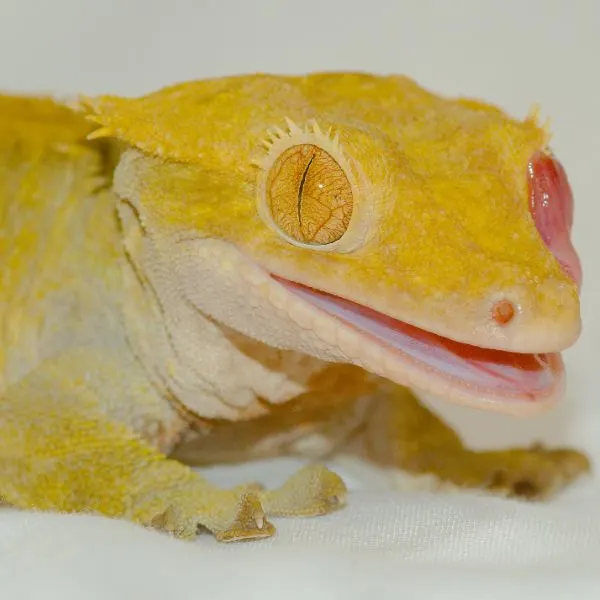
With an average length of 8 inches and a length range of 6 to 10 inches, this is one of the largest gecko species in the world. They also have a long tail which can grow up to 4 to 6 inches. Crested geckos have hair-like extensions/projections over their eyes.
The hair-like extensions look like eyelashes, which is why the crested geckos are also popularly referred to as eyelash geckos. The eyelashes are the main distinguishing feature of this gecko.
Additionally, they have a large triangular head, large ear openings, and big eyes. They come in different morphs and colorations.
The three main morphs seen among wild crested geckos include patternless (a solid body color ranging from grey, red, brown, or green to yellow with faint or no patterns), tiger (a light body color with darker stripes and a patterned underside), and white-fringed (yellowish-white color on the entire body or parts of their calcareous crest).
Are Crested Geckos Good as Pets?
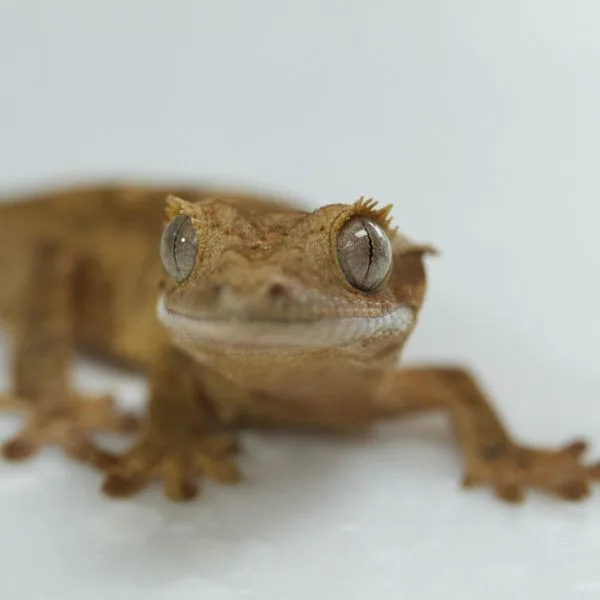
The simple answer is yes, crested geckos are good pets. They are great for beginners and expert reptile enthusiasts alike and will make a great, docile pet that will be part of the family for many years.
After the initial set up including lights, tank, interior items, and of course the gecko itself, they cost very little. The most money will be spent on food, and since they eat mostly fruits and insects your costs will be minimal.
They are typically very healthy animals as well. With proper care, you’ll most likely only pay a vet for a routine check-up once or twice a year.
Crested geckos are docile and take to handling well. When you first get your pet, it may be very skittish, but over time it will allow more handling. Just don’t keep it out of the enclosure for a long time as they can’t produce their own body heat and may get too cold.
Remember to wash your hands after handling any reptile, this includes lizards, turtles, and snakes as they can carry salmonella which can be transmitted to humans.
You can also house a few geckos together. Keep in mind though, that each gecko needs at least 20 gallons of space. When keeping two together in the same tank, they should have a 40-gallon enclosure at a minimum.
It’s not recommended to keep two male crested geckos together or to have more than three in a single tank. Too many of these lizards housed together can create stress as they compete for food, water, and space.
One bad thing about geckos is they are crepuscular. This means they are most active during twilight and dawn hours.
They will hide away and sleep during the day, and darkest hours of the night, so you won’t see them moving around much when most people are active.
Do Crested Geckos Like to be Handled?
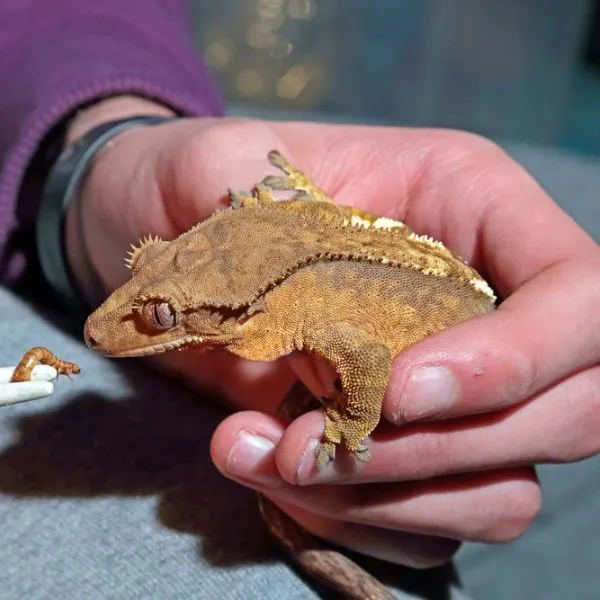
Most crested geckos, once they are familiar with you, will like to be handled and they will often come to you when you put your hand into their enclosure. When you first bring your crestie home, it will be shy, it may run away from you, or even show signs of aggression.
When moving in your new pet, you should give it a few weeks to get used to its new surroundings before you try to handle it. When you do start to handle them take it very slow so you don’t stress it out. Too much stress can cause it to drop its tail or become ill.
If your crested gecko runs away from your hand, tries to jump off, or shows aggression, back away slowly, and attempt again in a day or two until it begins to trust you. Patience is key here, rough handling or fast, jerky movements will only cause a setback.
Keep in mind that crested geckos are more active during twilight and dawn, so these will be the best times to attempt handling.
Once you have gained your crested gecko’s trust, and it’s crawling on your hand or up your arm, don’t keep it out for more than 15 minutes per session. If he or she starts to get fidgety, tries to run away from you, or becomes aggressive, then you should put it back.
When you are first handling your crestie, put the enclosure on the floor and put padding around you while holding it. Just in case it tries to jump off, there will be a shortfall and soft landing.
Are Crested Geckos Easy to Care For?
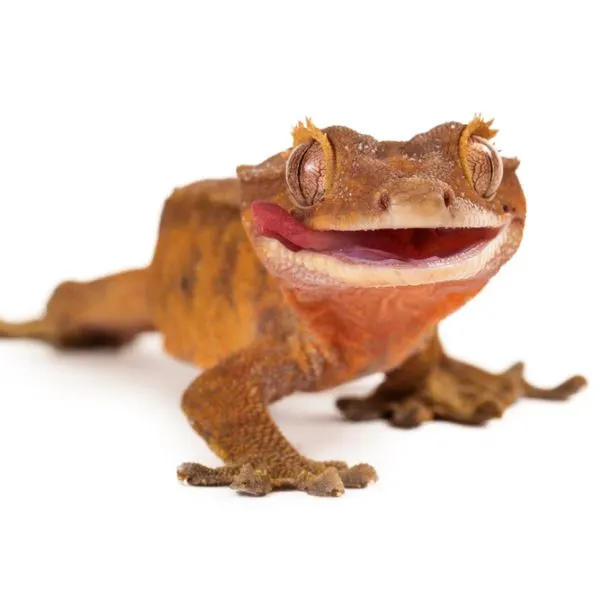
Crested geckos are one of the easiest pets to care for. After you get their tank set up, the most you will have to do with them is to feed them—typically every other day—provide fresh water daily, mist them on occasion, and clean up their excrement.
You can purchase complete gecko food which provides all the nutrients a gecko will need without doing much prep. Most times they won’t need supplemental lighting or heat, and they rarely get sick, so you won’t have constant vet visits.
They also don’t make a lot of noise or create a lot of waste. They can chirp quietly or squeak sometimes but they are not loud and don’t vocalize often.
Though you will have to clean their enclosure on occasion, it’s minor compared to an aquarium full of fish.
Can Crested Geckos Hear?
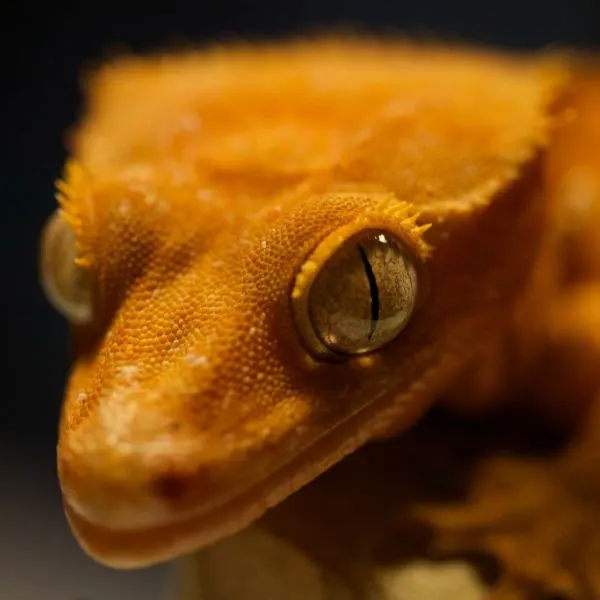
Though crested geckos don’t have external ears as we do, they have ear holes and internal organs similar to ours, so yes, crested geckos can hear.
It’s thought that crested geckos either can’t hear or don’t hear low-frequency noises very well, but they are quite sensitive to high-pitched sounds like bird calls and insect trills. They use these noises to avoid potential predators or to find food (insects).
While everyday noises like the TV, household appliances, and conversations are fine and geckos get used to them, very loud, or sudden noises can frighten them. Prolonged loud noises can even cause them stress.
Crested Gecko Habitat
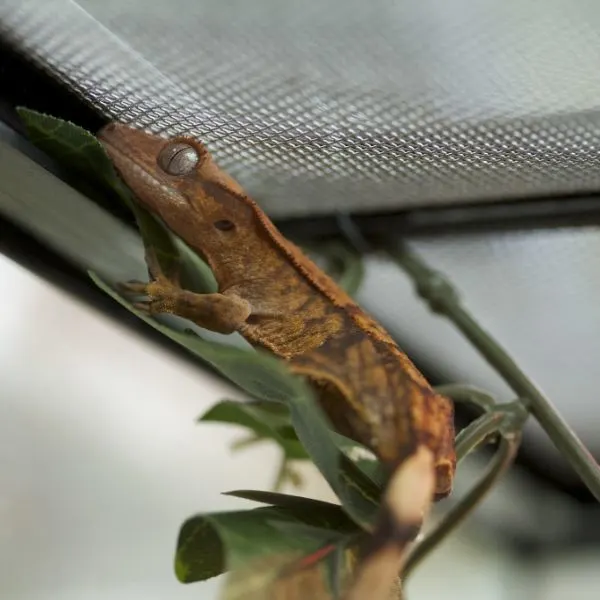
Most wild crested geckos can be found in the rainforests of Grand Terre, New Caledonia the typical temperature range is 72 to 75 F (22.2 to 23.9 °C). In their natural habitat, rainfall levels can be as high as 4000 mm a year.
They spend all their time in trees, where they rest during the day and forage during the night. As you can see, they need a room-level temperature, regular misting, and a tall enclosure with much vegetation.
The Best Enclosure for Crested Geckos
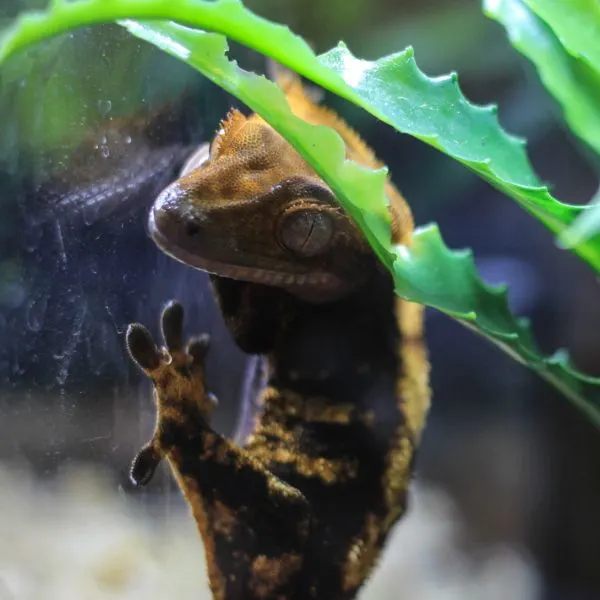
When choosing an enclosure for this gecko, ensure it is one that allows the geckos to climb vertically. Housing them in an aquarium isn’t best even if it is a tall vertical aquarium.
First, ventilation in an aquarium would be poor, misting the enclosure would be difficult, and so would every other husbandry practice. Get a terrarium designed for tropical reptiles.
These have front-opening glass panels so you can easily open up the enclosure to feed the gecko, mist the enclosure, and check on the vegetation there.
For juveniles, I recommend a 12x12x18 inches tall terrarium such as the Exo Terra Crested Gecko Kit, Small. This enclosure has a capacity of 10 gallons.
For adults, I recommend a tall terrarium with measurements of 18x18x24 inches such as the Exo Terra AllGlass Terrarium which has a capacity of 20 gallons.
It also has dual front opening doors and a full metal screen for the top ventilation. It even comes with tropical rainforest decorations such as jungle vines and jungle ropes.
Get a lot of plants in the terrarium either live or fake. Each (live or fake) has its advantages and disadvantages. While live plants help maintain good humidity levels, they also require the right potting mix, fertilization, and adequate lighting to grow well. Fake plants, on the other hand, are maintenance-free.
Just ensure you get plants that can thrive in a humid environment. Some plants to consider include figs, pothos, and bromeliads. Jungle vines and ropes also add to the aesthetics of the enclosure. Additionally, they provide climbing opportunities. Driftwood and bark are also good decorations to have in the terrarium.
How Big of a Tank Does a Crested Gecko Need?

You should get at least a 20-gallon tank for a single gecko, but the most important factor in gecko enclosures is height. Geckos are found in trees in the wild and like to climb, so a lot of floor space isn’t a factor.
While babies and juvenile cresties are fine in five and 10-gallon tanks, once they are adults they will need more space. If you can afford it when you first purchase your new pet, I would suggest getting at least a 20-gallon enclosure so they can grow into it.
If you are housing more than one gecko in an enclosure, plan on giving each adds their own 20 gallons of space. For two cresties you’d need 40 gallons, for three you should have a 60-gallon tank, and so on.
If you are planning on breeding crested geckos, then you could go with a few smaller tanks to house them until they are sold.
What Kind of Substrate do Crested Geckos Need?

When thinking of substrate, you got to think of the live plants in the terrarium as well as the geckos. For the plants, use potting mix (I recommend equal portions of coco coir and sterile soil).
For the reptiles, the substrate has to be one that maintains humidity well such as peat moss, coco fiber, and cypress mulch.
The substrate should be deep and plentiful enough to cover the floor of the reptile house properly. Damp paper towels or old newspapers also work well.
They are easy to find, and would likely cost you nothing. Paper isn’t preferred by most reptile keepers since it isn’t aesthetically pleasing.
However, when you newly acquire a gecko, whether an adult or a baby, use damp newspapers or paper towels for at least two weeks.
Since the crested gecko hardly goes to the floor of the terrarium, as far as the bedding holds moisture well, it would work. Avoid substrates made of cedar as it’s toxic to reptiles.
Do Crested Geckos Need Heat Lamps?
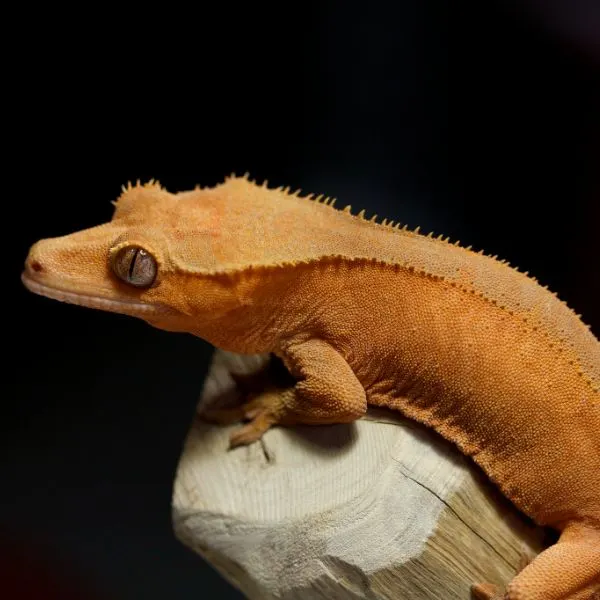
In most situations, a crested gecko won’t need a supplemental heat lamp. They typically do well in room temperature settings between 72℉ to 78℉ during the day, and between 69℉ to 74℉ at night.
In cooler regions, or during the winter months, you may need a heat lamp to keep the enclosure at an optimal temperature.
Areas, where the temperature inside the house is often above 78℉, will need to be kept in a cooler room so the temperature doesn’t harm your reptile.
Temperature

Try to keep the temperature at around 75 F. Temperature levels shouldn’t go above 78 F. On the opposite end, the temperate during the day shouldn’t fall below 62 F.
As you can see the temperature levels needn’t be high. If you live in a place where temperatures are consistently above 82 F, then you need to place the enclosure in a cooler room. When the temperatures are high, the crestie can get stressed. This is bad for its health.
Since the gecko is arboreal, a heat mat wouldn’t be of any good. For vertical enclosures, you can use a heat lamp to warm up the enclosure when temperatures are low.
During the night, the lamp can be turned off to save energy. A ceramic heat emitter such as Fluker’s Ceramic Heat Emitter is a good choice. Another excellent choice is a mercury vapor lamp. Position the lamp above the enclosure, if one is necessary.
Get a thermostat (such as the WILLHI Temperature Controller) for the heat emitter so it doesn’t produce too much heat. Place the lamp over the screen top to one side of the terrarium.
This will create a temperature gradient. The gecko can move towards the heat source or away from the heat in order to regulate its body temperature.
Do Crested Geckos Need Humidity?

Crested geckos come from a tropical island so they will require high humidity levels to thrive. How humid should those levels be?
They need humidity levels between 60% to 80% for optimum health. Achieve this by misting the enclosure daily.
To prevent the buildup of mold and mildew which will grow in constantly very humid environments, you should let the humidity dry out to 50% to 40% before misting again. Misting the enclosure also helps to keep your reptiles hydrated; crested geckos lick water droplets off the leaves of the plants and off the glass panels of the terrarium.
Alternatively, you can place a cool mist humidifier next to the enclosure. The presence of live plants also helps regulate humidity levels.
In order to monitor the proper humidity and temperature in your crested gecko’s environment, try out this Zoo Med Labs Digital Thermometer Humidity Gauge. With the accurate, digital readout you can quickly and easily see the conditions of your enclosure.
Do Crested Geckos Need Light

As long as they are fed a diet supplemented with vitamin D3, they don’t need extra UV light, but there are benefits to adding a UVA/UVB light.
Adding light to the terrarium will help to regulate the circadian rhythm. This is the natural waking and sleeping cycle that is determined by alternating light and dark periods. If the light is too low, or there isn’t any natural light, this could mess up your crestie’s sleep schedule.
UV lights help to manufacture vitamin D3 in crested geckos. Just like sunlight does for humans, this necessary nutrient helps with the absorption of calcium. Although your gecko may be getting enough vitamin D3 through supplements, receiving it naturally is always better.
A small UV light in your terrarium can also stimulate your crested gecko’s appetite which will help them maintain a healthy weight.
However, if you have live plants in the aquarium, you need to provide UV light for the plants. Many plants can grow with indirect sunlight light. You can place the terrarium in a sunlit room.
Just don’t place the terrarium in the path of direct sunlight as this can quickly heat up the glass terrarium. The terrarium can be placed adjacent to the window but never right in front of a window.
Also, you can have a fluorescent light that runs the length of the tank. The lights should go off during the night.
How to Feed Crested Geckos

Crested geckos in the wild are primarily insectivores, but they will also consume soft fruits on occasion. When feeding your geckos, you have options, especially if you are hesitant to have live insects in your house.
Crested geckos don’t need live insects to survive. They gladly accept replacement gecko diets. The exclusion of live insects from their diet is one of the reasons why they are such popular lizards, but they still need some nutrition that comes from insects.
I recommend the Repashy Grubs ‘N’ Fruit Crested Gecko Diet. Geckos enjoy it and it provides them with all the nutrients (both macronutrients & micronutrients) they need to be healthy and active. It also has a decent mix of insect matter (30%) for complete nutrition.
Another popular brand of gecko diet is the Pangea Fruit Mix Fig & Insects Crested Gecko Complete Diet. This brand comes in different flavors such as banana, apricot, papaya, and watermelon.
The powdered diet needs to be mixed with two parts of water—to create a baby food consistency—and served in a shallow dish four to five times a week. It may take a while for them to eat enough, so the food needs to remain in the enclosure for a day and a half before you remove it.
Since geckos are typically nocturnal, you may not see them eat much during the day. Make sure to leave the food overnight, and replace it if the paste starts drying out and becomes too firm for your gecko to eat.
Other foods the cresties enjoy include pieces of fruits and live insects such as roaches and crickets. Fruits can be fed as a treat once every two weeks. Live insects can be their main food or a supplementary diet.
What Fruits Can Crested Geckos Eat?
Popular fruits you can feed your gecko include:
- Watermelon
- Dates
- Figs
- Strawberries and blueberries
- Bananas
- Pears
- Mangos
- Plums
- Peaches
- Apricots
- Grapes
Stay away from these fruits as they either contain high levels of oxalic acid—which prevents calcium absorption—or they can be hazardous to your gecko’s health:
- Star fruit
- Any citrus, oranges, lemons, limes, grapefruit, etc.
- Kiwi
- Pineapple
- Rhubarb
- Avocado
When feeding fruits, either cut them into very small chunks or blend/mash them.
The cut chunks need to be equal to or less than the distance between their eyes. Geckos don’t chew their food, they swallow it whole so the pieces need to be small enough they don’t get stuck.
What Insects Do Crested Geckos Eat?
If you’re not squeamish about live insects and want to give your geckos the most natural diet possible, there are many ways to accomplish this. You can purchase live insects online through various retailers, or get them from your local pet store.
When feeding live insects, you should offer them about two times per week, in between fresh fruits or gecko diet mixes. Popular insects for crested geckos include:
- Locusts
- Crickets
- Dubia roaches
- Waxworms
- Mealworms
- Hornworms
- Silkworms
Calcium Supplement
The crickets need to be dusted with a vitamin supplement such as the Zoo Med Reptile Calcium with Vitamin D3. The length of the crickets needs to be equal to the width of the gecko’s head.
Water
Provide the crestie with water at all times. A shallow sturdy dish of water should be placed at the bottom of the enclosure. It needs to be full throughout the day. Change the water and clean the dish daily.
The crested gecko would likely excrete into the water but that’s normal. Wash the dish with water and a brush. Don’t use soap, the residue can be harmful to the reptile.
Crested Gecko’s Temperament

As generally docile reptiles, the crested gecko is easy to handle. It also makes a great display pet. Wait for the gecko to be at least 3 inches from snout to vent before you handle them.
Small crested geckos are flighty and injure easily. Even adults don’t handle it for more than five minutes. If you have just acquired an adult crested gecko, wait for a month before you attempt to handle it. It needs to get settled in first.
Crested geckos can be quite skittish and as such may drop their tails when handled roughly. Unlike other geckos, their tails can’t grow back.
Also, losing their tail isn’t harmful to their health as with leopard geckos. In fact, in the wild, almost all adult cresties lose their tail.
Can Crested Geckos Live With Other Reptiles?
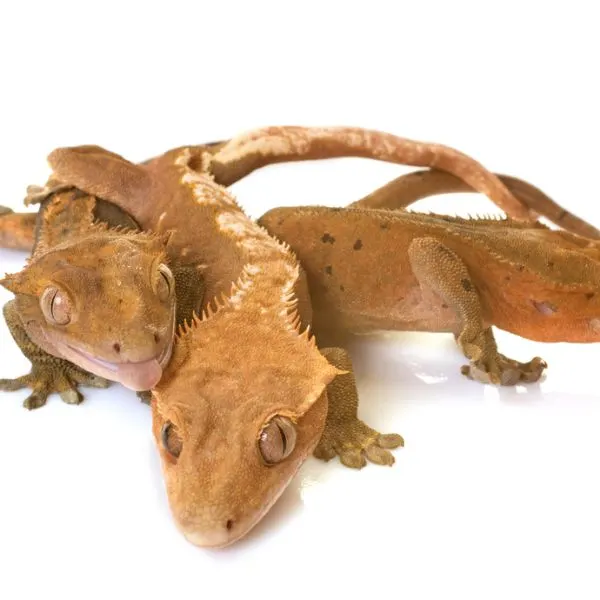
Given the specific temperature, humidity, and food requirements crested geckos need, it’s not advised to house them with inhabitants other than their own kind. Even leopard geckos require a different setup.
Bearded dragons require hot, dry environments and don’t need to eat a lot of fruit, so they are out, snakes are of course predators and will eat the geckos, and even frogs need different environmental factors.
Depending on the frog size and species, the geckos may try to eat the frogs, or vice-versa.
Crested geckos live a happy and healthy life on their own, or with one or two of their kind, though there are some requirements to housing them together. You shouldn’t put multiple male geckos together as they are territorial and will fight.
A male and a female will do alright together, but you will most likely end up getting plenty of little crested gecko eggs and babies.
You can house up to three females together if you have plenty of space, and once a dominant female asserts herself as the leader.
How Long do Crested Geckos Live?
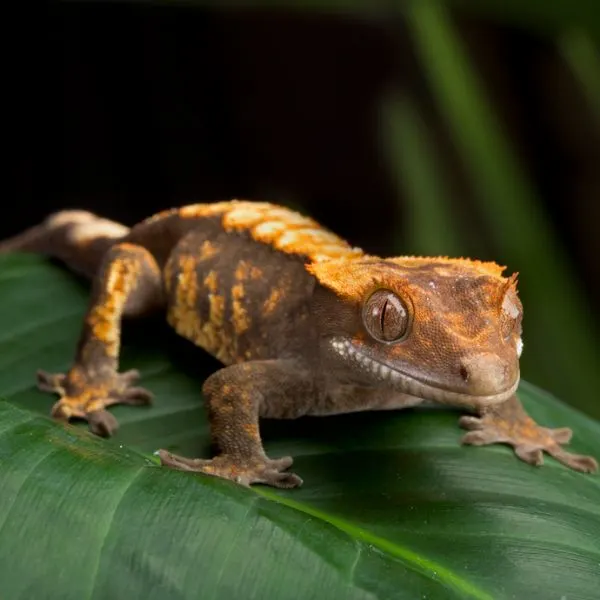
With the proper care and handling, a crested gecko can live between 15 to 20 years in captivity. Most people wouldn’t assume a lizard could live longer than most cats and dogs, but even in the wild, these little lizards have a decade-long lifespan.
If you are planning on getting a crested gecko as a pet, make sure your family is ready for a long commitment.
Common Health Concerns

As with any pet, poor health is a concern. With proper husbandry, you should be able to keep poor health and illnesses to a minimum.
Regardless, they can suffer from a variety of illnesses. The most common ones are highlighted below.
Metabolic Bone Disease (MBD)
This is a result of calcium deficiency. This disease leads to weak bones as the body metabolizes them for calcium. Some symptoms include weak jaws, swollen limbs, a humped back, kinks, the bowing of the spine, and tremors.
Other symptoms of metabolic bone disease in crested geckos can include lethargy, shakes or tremors when trying to move, or a crooked tail. It is often found in juveniles and egg-laying females.
Juveniles require more calcium during bone growth, and egg laying requires an excess of calcium to develop the eggs.
Providing a proper diet is essential to prevent MBD. If you feed them live insects, ensure the insects are gut-loaded and dusted with vitamin D3 and calcium supplements.
Crickets and other insects are high in phosphorous which can impede calcium absorption. To make feeding time easier on yourself, feed them crested gecko meal replacement powder diets.
The advantage of this diet is that it contains all the nutrients the gecko needs.
Sand Impactions and Prolapse
When the lizard ingests loose substrate such as soil, it can lead to blockages in their intestines. This is especially common among babies and juveniles who eat substrates as they explore and acclimatize to their enclosure.
That is why it is important to use paper towels or newspapers for babies, juveniles, and newly acquired crested geckos. Signs of sand impaction include refusal to eat and constipation.
Why Do Crested Geckos Lose Their Tail?
This is a common defense mechanism among geckos, and the crested gecko is no exception. However, unlike other geckos, the crested gecko cannot grow back a dropped tail.
Crested geckos drop their tail when they feel threatened. A dropped tail will twitch and move about, catching the attention of a predator so the crested gecko can flee to safety.
Take it slow around your gecko especially when you first get it. Let them get used to you because humans are so much bigger than they are, we can look like scary predators to them.
If you threaten the gecko or handle it roughly, the tail can drop. If you house several geckos together they may fight and drop their tails, especially juvenile cresties as they fight to assert dominance.
To avoid an accidental tail drop, don’t handle your gecko if it runs away from you, shows jerky movements when you approach, and doesn’t handle them roughly.
Always supervise children around your gecko as well, sudden movements, loud noises, or bright flashing lights might cause your gecko to lose its tail.
A dropped tail shouldn’t be an issue, and it won’t affect the lizard negatively once it heals. If your crested gecko drops its tail, you don’t have to do anything unless it shows signs of infection.
The tail often heals on its own easily, but if you notice redness or swelling at the tail stump you can apply an antibacterial gel. If it does start to ooze or does not get better, then you should contact your vet for further care.
Why Isn’t My Crested Gecko Eating?
New and smaller geckos may not eat much. In fact, they may be eating but they take in so little, that the food dish looks untouched. Crested geckos don’t typically eat every day either, so it may be a few days before you notice they have eaten.
Stress can also reduce their appetite. Whether they have been recently moved, a new tank mate has been introduced, or they aren’t feeling well, a stressed crestie likely won’t have much of an appetite.
If the enclosure is constantly below 70℉ this too can reduce their appetite. Make sure the temperature is at least 72℉ during the day to stimulate their appetite.
Some crested geckos can be picky. They may not like the flavor of the food you offer, or it could be they dislike the texture. Some will like their food runnier or thicker and more paste-like. This could be a trial and error situation.
If you have multiple cresties in an enclosure it can be hard to tell if one is not eating, but there could be a bullying situation going on. The only way to find out if this is happening—aside from watching them all 24-7—is to separate them and see who is eating, and who is not.
Illness like impaction could be a problem as well. When a crested gecko is impacted, it won’t eat much until the impaction has been passed. To find out if your crestie is eating or is impacted, look for their poop.
They should poop once to twice a day if they are eating. No excrement day after day could be a problem. If you don’t notice any new feces in the tank after a week, consult your vet for the next steps, they may want you to bring your pet in for an examination.
Some owners report that their geckos seem to eat after misting. Try to wait until early evening hours or early morning to mist your lizard and see if this helps them to eat if you’re unsure if it’s eating.
How Much is a Crested Gecko?

These popular pets are readily and easily bred. As such, they aren’t pricey.
On average, they should cost between $40 to $100 for a plain crested gecko. The average price could vary depending on availability in your area though.
If there aren’t many crested gecko breeders around, and pet stores don’t typically carry them, people will charge more because of supply and demand.
Of course, rarer morphs cost more. Some rare morphs cost as much as $1000. Popular morphs include Pinstripe, Tiger, Yellow, Flame, Dalmatian, Dark, Brindle, Red, Cream, and Harlequin.
Some online sites to acquire this delightful reptile include Tiki’s Geckos, Underground Reptiles, and Morph Markets (which specializes in morphs).
Conservation and Threats
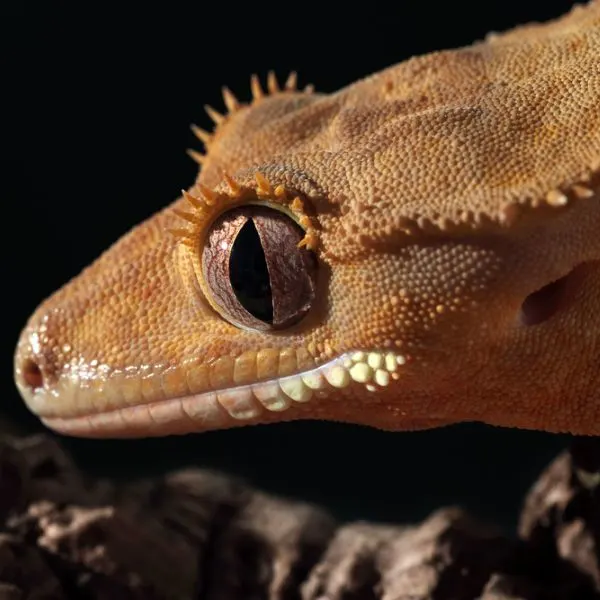
As a species that was recently rediscovered, very little is known about geckos in the wild and the impact of human activities on wild populations. However, in the wild, their population is falling.
This is believed to be caused by bad farming practices (such as slash and burn farming), the introduction of non-native species, and mining. They are listed as Vulnerable on the IUCN Red List.
FAQ
Do crested geckos bite?
A: Crested geckos are generally docile, and don’t bite very often. If they do bite, it won’t hurt because they have minuscule teeth that won’t penetrate the skin, and they have weak jaws.
Do crested geckos make any noises?
A: Most geckos make noises of some kind. The crested gecko can chirp, squeak, or make clicking sounds depending on its mood, if it was frightening, or is communicating with other geckos.
Do crested geckos close their eyes when they sleep?
A: No, crested geckos do not have eyelids, so they can’t close their eyes. When they sleep they close their pupils as much as possible to reduce the amount of light coming in.
Conclusion
Are Crested geckos excellent pets? Yes, they are.
They may just be the best pets for beginners. While you need to mist the enclosure daily, feeding them is easy. You don’t need to deal with noisy crickets or other live insects.
They also come in several colors. Some are bright solid red while some are chocolate in color. There are also striped and pinstripe crested geckos.
The color ranges are many. Lastly, the arboreal crested gecko is fun to watch. If you have any comments, we would love to hear them. Thanks.
More Cool Stuff
- Lizard Species
- Gargoyle Gecko Care Sheet
- Mourning Gecko Care Sheet
- Gold Dust Day Gecko Care Sheet
- Crested Gecko vs Leopard Gecko
- Crested Gecko Setup Guide
- Can leopard geckos live together?
